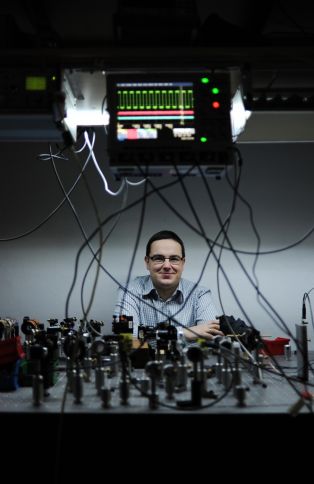Efficient waveguide source of precisely controlled photons
2012-02-29

Photons with precisely specified properties are indispensable to nearly all experiments in quantum optics as well as in a growing number of its applications. Scientists from the Faculty of Physics, University of Warsaw have constructed a device which makes the generation of such photons easier and less expensive.
Numerous quantum optics experiments require the use of sources of single photons with precisely controlled properties. A source which is significantly more efficient than the standard ones has been constructed at the Faculty of Physics, University of Warsaw (FP UW). “The device we have constructed is not only more efficient, it also allows a more precise control of the generated photons’ parameters. Quantum experiments can now be carried out faster, more easily and, most importantly, at a lower cost,” says Prof. Czesław Radzewicz, head of the Ultrafast Phenomena Laboratory of the Institute of Experimental Physics FP UW.
Photon sources used in quantum optics experiments have so far relied on spontaneous frequency conversion in bulk nonlinear crystals and have not been efficient. Even when a crystal is illuminated with a laser beam with a power of several dozen milliwatts, a relatively high one for quantum experiments, it generates just several tenths of thousands appropriate photons per second.
For over a decade physicists have been trying to generate single photons not only in bulk crystals but also in nonlinear waveguides, using the phenomenon of spontaneous parametric frequency conversion, also called parametric fluorescence. Despite the name, parametric fluorescence has little to do with ordinary fluorescence, which consists in gradual emission of energy by atoms that have been previously excited. “During parametric fluorescence, emission is immediate and does not result from excitation of atoms but from specific nonlinear properties of electric potential which binds electrons in atoms,” explains Michał Karpiński, PhD student from the Faculty of Physics, University of Warsaw, the leading author of a publication in the “Optics Letters” journal, where the new photon source has been described.
As a result of parametric fluorescence, the initial photon from a pump beam is being split in the waveguide into two photons the energy of which is two times lower. This means that if a pump photon is a blue light photon with a wavelength of 400 nm, then two red light photons with a wavelength close to 800 nm are generated as a result of parametric fluorescence.
Properties of such photons are correlated in such a way that if, for example, one of them is polarized in one plane, the other one has a perpendicular polarization. Having obtained such a pair of photons, physicists can direct it at a crystal selecting photons with different polarizations. If a photon with a particular polarization is registered in one arm of a measurement system, it is immediately clear that its twin photon, perpendicularly polarized, was in the other arm. This knowledge is put to use, among others, in experiments with photonic entanglement.
A commercially available nonlinear waveguide has been used in the source constructed at the Faculty of Physics, University of Warsaw. In contrast to traditional optical fibres, it is not a flexible fibre but a crystal of a size of several millimetres. On its surface there is a waveguiding optical line, through which a pump beam is transmitted.
“The key to success was gaining insight into the physics of dispersion phenomena which occur in our nonlinear waveguide. We have been studying similar systems for several years and in 2009 we published one of the first experimental studies of these phenomena. Hence, we knew exactly what parameters a beam passed through a waveguide should have, what spectral filters we should place in front of and behind the waveguide and what the end result would be,” emphasizes Konrad Banaszek, PhD, professor at the University of Warsaw.
The number of photons emitted by the new source is around hundred times higher than in typical existing sources. This means that a pump beam passed through a waveguide can be less powerful and can come even from an ordinary diode laser. There is an additional advantage; a weaker pump beam will scatter to a lesser extent in the experimental system and will disturb measurement results to a lesser degree.
The research was financed from European Union funds under the TEAM programme of the Foundation for Polish Science and from a PhD research grant from the Polish Ministry of Science and Higher Education. The results may be used in experimental works related to quantum optics and its applications: quantum encryption, quantum memories or quantum metrology, in which the use of quantum states of light allows to carry out highly precise measurements.





